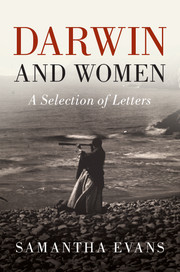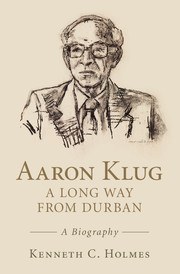Refine search
Actions for selected content:
10305 results in History of science: general interest
John Krige , Sharing Knowledge, Shaping Europe: US Technological Collaboration and Nonproliferation. Cambridge, MA: MIT Press, 2016. Pp. 227. ISBN 978-0-262-03477-7. £24.95 (cloth).
-
- Journal:
- The British Journal for the History of Science / Volume 50 / Issue 1 / March 2017
- Published online by Cambridge University Press:
- 31 March 2017, pp. 165-167
- Print publication:
- March 2017
-
- Article
- Export citation
Kelly Joan Whitmer , The Halle Orphanage as Scientific Community: Observation, Eclecticism, and Pietism in the Early Enlightenment. Chicago and London: The University of Chicago Press, 2015. Pp. 200. ISBN 978-0-226-24377-1. £28.00 (hardback).
-
- Journal:
- The British Journal for the History of Science / Volume 50 / Issue 1 / March 2017
- Published online by Cambridge University Press:
- 31 March 2017, pp. 146-148
- Print publication:
- March 2017
-
- Article
- Export citation
Alison D. Morrison-Low , Sara J. Schechnerand Paolo Brenni(eds.), How Scientific Instruments Have Changed Hands. Leiden and Boston: Brill, 2016. Pp. 239. ISBN 978-90-04-32492-3. €125.00/$150.00 (paperback).
-
- Journal:
- The British Journal for the History of Science / Volume 50 / Issue 1 / March 2017
- Published online by Cambridge University Press:
- 31 March 2017, pp. 149-150
- Print publication:
- March 2017
-
- Article
- Export citation
Eric Dietrich , Excellent Beauty: The Naturalness of Religion and the Unnaturalness of the World. New York: Columbia University Press, 2015. Pp. 208. ISBN: 978-0-231-17102-1. £20.50 (hardback). - Roger Wagnerand Andrew Briggs , The Penultimate Curiosity: How Science Swims in the Slipstream of Ultimate Questions. Oxford: Oxford University Press, 2016. Pp. xiii + 496. ISBN 978-0-19-874795-6. £25.00 (hardback).
-
- Journal:
- The British Journal for the History of Science / Volume 50 / Issue 1 / March 2017
- Published online by Cambridge University Press:
- 31 March 2017, pp. 160-162
- Print publication:
- March 2017
-
- Article
- Export citation
Knowledge of childhood: materiality, text, and the history of science – an interdisciplinary round table discussion
-
- Journal:
- The British Journal for the History of Science / Volume 50 / Issue 1 / March 2017
- Published online by Cambridge University Press:
- 23 February 2017, pp. 111-141
- Print publication:
- March 2017
-
- Article
- Export citation
Needham at the crossroads: history, politics and international science in wartime China (1942–1946)
-
- Journal:
- The British Journal for the History of Science / Volume 50 / Issue 1 / March 2017
- Published online by Cambridge University Press:
- 21 February 2017, pp. 83-109
- Print publication:
- March 2017
-
- Article
-
- You have access
- HTML
- Export citation

Darwin and Women
- A Selection of Letters
-
- Published online:
- 16 February 2017
- Print publication:
- 05 January 2017

Aaron Klug - A Long Way from Durban
- A Biography
-
- Published online:
- 16 February 2017
- Print publication:
- 09 February 2017
Berber genealogy and the politics of prehistoric archaeology and craniology in French Algeria (1860s–1880s)
-
- Journal:
- The British Journal for the History of Science / Volume 50 / Issue 1 / March 2017
- Published online by Cambridge University Press:
- 16 February 2017, pp. 61-81
- Print publication:
- March 2017
-
- Article
- Export citation
How lives became lists and scientific papers became data: cataloguing authorship during the nineteenth century
-
- Journal:
- The British Journal for the History of Science / Volume 50 / Issue 1 / March 2017
- Published online by Cambridge University Press:
- 16 February 2017, pp. 23-60
- Print publication:
- March 2017
-
- Article
-
- You have access
- HTML
- Export citation
Appendix B: - Diffraction
- from Appendices
-
- Book:
- Aaron Klug - A Long Way from Durban
- Published online:
- 16 February 2017
- Print publication:
- 09 February 2017, pp 317-333
-
- Chapter
- Export citation
6 - Birkbeck-1
- from Part I - From Durban to Birkbeck College
-
- Book:
- Aaron Klug - A Long Way from Durban
- Published online:
- 16 February 2017
- Print publication:
- 09 February 2017, pp 75-92
-
- Chapter
- Export citation
16 - Zinc Fingers
- from Part II - Science at the Laboratory of Molecular Biology
-
- Book:
- Aaron Klug - A Long Way from Durban
- Published online:
- 16 February 2017
- Print publication:
- 09 February 2017, pp 222-232
-
- Chapter
- Export citation
Part III - Duties and Rewards
-
- Book:
- Aaron Klug - A Long Way from Durban
- Published online:
- 16 February 2017
- Print publication:
- 09 February 2017, pp 233-308
-
- Chapter
- Export citation
Appendix C: - Aaron Klug’s Scientific Publications
- from Appendices
-
- Book:
- Aaron Klug - A Long Way from Durban
- Published online:
- 16 February 2017
- Print publication:
- 09 February 2017, pp 334-354
-
- Chapter
- Export citation
7 - Birkbeck-2
- from Part I - From Durban to Birkbeck College
-
- Book:
- Aaron Klug - A Long Way from Durban
- Published online:
- 16 February 2017
- Print publication:
- 09 February 2017, pp 93-122
-
- Chapter
- Export citation
Part I - From Durban to Birkbeck College
-
- Book:
- Aaron Klug - A Long Way from Durban
- Published online:
- 16 February 2017
- Print publication:
- 09 February 2017, pp 1-122
-
- Chapter
- Export citation
Index
-
- Book:
- Aaron Klug - A Long Way from Durban
- Published online:
- 16 February 2017
- Print publication:
- 09 February 2017, pp 355-368
-
- Chapter
- Export citation
12 - From Thon Rings to Modern Dance
- from Part II - Science at the Laboratory of Molecular Biology
-
- Book:
- Aaron Klug - A Long Way from Durban
- Published online:
- 16 February 2017
- Print publication:
- 09 February 2017, pp 171-183
-
- Chapter
- Export citation
9 - Image Analysis in Electron Microscopy
- from Part II - Science at the Laboratory of Molecular Biology
-
- Book:
- Aaron Klug - A Long Way from Durban
- Published online:
- 16 February 2017
- Print publication:
- 09 February 2017, pp 135-151
-
- Chapter
- Export citation
